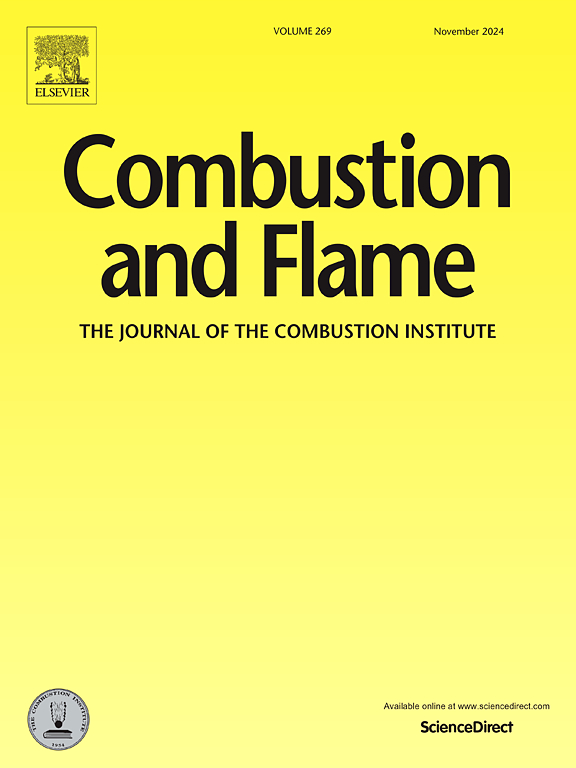Panoramic vision analysis of burning aluminum droplet and oxide cap with 360-degree microscopic photography
IF 5.8
2区 工程技术
Q2 ENERGY & FUELS
引用次数: 0
Abstract
The aluminum agglomerate surfaces serve as the essential interfaces for heat and mass transfer processes during combustion, with the attached oxide cap exerting a significant effect on the asymmetrical spatial distribution of agglomerate physical properties. Therefore, understanding the surface characterization and its dynamic evolution during aluminum combustion is important. However, significant challenges exist in visualizing and measuring agglomerate surfaces due to the micrometer-scale size, extremely rapid dynamic evolution, asymmetric three-dimensional morphology, and complex combustion behaviors. Traditional methods are limited in providing three-dimensional, in situ measurements of agglomerate surfaces under the propellant-burning environment. Thus, a panoramic vision analysis method is proposed to achieve 360-degree visualization and measurement of agglomerate surfaces. A high-speed panoramic microscopic imaging system up to 30 kHz is established, composed of two high-speed cameras positioned opposite each other to capture the panoramic view of agglomerates. A data processing pipeline, incorporating an artificial intelligence segmentation algorithm and an ellipsoid geometric model, is developed to reconstruct three-dimensional models of agglomerates with varying diameters over time. The oxide cap distributions and dynamic behaviors, such as rotation and drift on the droplet surface, are visualized. Quantitative measurements of oxide cap and droplet areas are also obtained, with oxide cap area ratios ranging from 10% to 40%. This study provides a method for visualization and quantitative measurement of agglomerate surfaces, offering a tool for further research on the mechanism of oxide cap dynamics on surfaces.
Novelty and significance statement
The novelty of this work lies in proposing a 360-degree panoramic vision analysis method, which enables three-dimensional surface visualization and quantitative measurement of burning droplets and oxide caps. A high-speed panoramic microscopic imaging system, operating at up to 30 kHz, is established by positioning two high-speed cameras opposite each other to capture the front and back sides of the agglomerates simultaneously. The experimental results demonstrate that the proposed method is competent in reconstructing three-dimensional models of agglomerates with varying diameters over time, allowing for visualizing the evolution of the oxide cap distribution and drift on the droplet surface. Quantitative measurements of the oxide cap and droplet areas are obtained, with the oxide cap area ratio ranging from 10% to 40%. This method provides technical support for deeper insights into the analysis of oxide cap dynamics.
360度显微摄影对燃烧铝液滴和氧化帽的全景视觉分析
铝团块表面是燃烧过程中传热传质过程的重要界面,附着的氧化帽对团块物理性质的不对称空间分布有重要影响。因此,了解铝燃烧过程中的表面特征及其动态演变具有重要意义。然而,由于微米尺度的尺寸、极快的动态演变、不对称的三维形态和复杂的燃烧行为,在可视化和测量团聚体表面方面存在重大挑战。传统的方法在提供推进剂燃烧环境下团聚体表面的三维原位测量方面受到限制。为此,提出了一种全景视觉分析方法,实现团聚体表面的360度可视化和测量。建立了一个高达30 kHz的高速全景显微成像系统,由两台相对放置的高速摄像机组成,以捕捉团块的全景。利用人工智能分割算法和椭球几何模型,构建了一个数据处理流水线,用于重建随时间变化的直径团块的三维模型。结果显示了氧化帽的分布和在液滴表面的旋转和漂移等动态行为。还获得了氧化帽和液滴面积的定量测量,氧化帽面积比从10%到40%不等。本研究为团聚体表面的可视化和定量测量提供了一种方法,为进一步研究表面氧化帽动力学机理提供了工具。新颖性和意义声明本工作的新颖性在于提出了一种360度全景视觉分析方法,可以实现燃烧液滴和氧化物帽的三维表面可视化和定量测量。一个高速全景显微成像系统,工作频率高达30千赫,通过两台高速摄像机相对放置,同时捕捉团块的前后侧面。实验结果表明,所提出的方法能够重建随时间变化的粒径团块的三维模型,从而可视化氧化帽在液滴表面的分布和漂移的演变。对氧化帽和液滴面积进行了定量测量,氧化帽面积比在10% ~ 40%之间。该方法为深入分析氧化帽动力学提供了技术支持。
本文章由计算机程序翻译,如有差异,请以英文原文为准。
求助全文
约1分钟内获得全文
求助全文
来源期刊

Combustion and Flame
工程技术-工程:化工
CiteScore
9.50
自引率
20.50%
发文量
631
审稿时长
3.8 months
期刊介绍:
The mission of the journal is to publish high quality work from experimental, theoretical, and computational investigations on the fundamentals of combustion phenomena and closely allied matters. While submissions in all pertinent areas are welcomed, past and recent focus of the journal has been on:
Development and validation of reaction kinetics, reduction of reaction mechanisms and modeling of combustion systems, including:
Conventional, alternative and surrogate fuels;
Pollutants;
Particulate and aerosol formation and abatement;
Heterogeneous processes.
Experimental, theoretical, and computational studies of laminar and turbulent combustion phenomena, including:
Premixed and non-premixed flames;
Ignition and extinction phenomena;
Flame propagation;
Flame structure;
Instabilities and swirl;
Flame spread;
Multi-phase reactants.
Advances in diagnostic and computational methods in combustion, including:
Measurement and simulation of scalar and vector properties;
Novel techniques;
State-of-the art applications.
Fundamental investigations of combustion technologies and systems, including:
Internal combustion engines;
Gas turbines;
Small- and large-scale stationary combustion and power generation;
Catalytic combustion;
Combustion synthesis;
Combustion under extreme conditions;
New concepts.
 求助内容:
求助内容: 应助结果提醒方式:
应助结果提醒方式:


